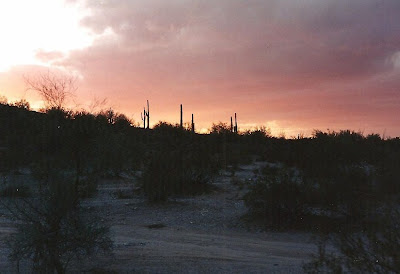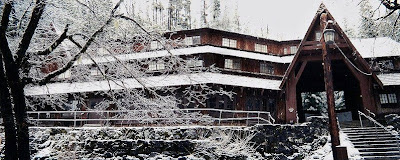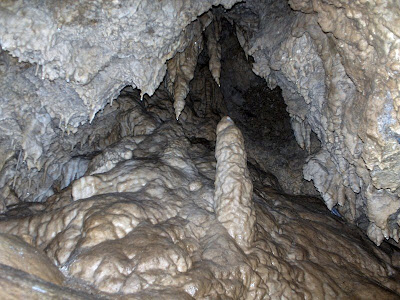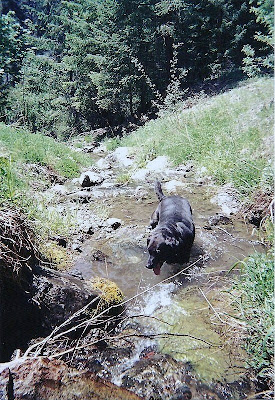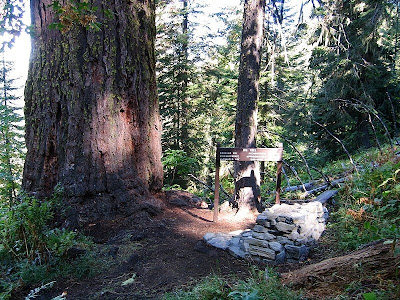.jpg)
Sunset over the Montezuma Valley from Mesa Verde National Park
While in Texas visiting my parents during the winter of 2005 I accepted a job as a seasonal Park Ranger from Mesa Verde National Park in southwest Colorado. So I had about 1200 miles to go. Mesa Verde translates as green table in Spanish.
.jpg)
Friends in Roswell
Along the way I stopped in Roswell, New Mexico to visit friends.
.jpg)
Mesa Verde museum
Occasionally I worked in the museum yet more frequently gave tours at three cliff dwellings and roved at Spruce Tree house.
.jpg)
Spruce Tree House from behind museum
.jpg)
Part of Spruce Tree House
The Ancestral Puebloan people—also known as Anasazi—occupied the Mesa Verde area as far back as 8,000-10,000 years ago. Once a nomadic people, they settled to dry farm around 450 AD with the introduction of corn, beans and squash that came from Mexico. Anthropologists believe some of the people moved from the mesa tops into the cliffs around 1200 to free more land for farming and perhaps for defense purposes.

Collared lizard photo by Jo Schrock
The Puebloans lived off the land in a severe environment of contrasts. The mesa tops out at 7,000 feet in elevation supporting a juniper and pinyon high desert forest. Heavy winter snows and summer monsoons brought sporadic water to the land. Yet the land provided fruit, nuts, acorns and wild onions. Plus the yucca, which I call the Wal-Mart of the mesa, with an edible flower and fruit, leaves made into fibers for weaving, and a root boiled and mashed into soap. Their meat diet included bear, elk, deer and mountain sheep, but mostly rabbits, birds, rodents and even lizards.
.jpg)
Cliff Palace from tour starting point
First discovered by John Wetherill while searching for stray cattle in December of 1888, Cliff Palace is the icon of Mesa Verde with 150 rooms. These amazing apartment-like structures were built with mortar and the local sandstone, block by block using levels and plum bobs, adding new rooms as needed. However, this tour is not for the faint of heart. First we descend about 100 feet on uneven steps carved into the stone. We will follow a trail along the front of the alcove making a couple stops along the way. Then we’ll climb the far stairs and a small ladder to gather by the big square tower before we leave the site by climbing five 8-10 foot ladders for a 100 foot vertical climb back to the mesa top.
.jpg)
Ladders out of Cliff Palace
An even more adventurous tour awaits us at Balcony House. There is a 120 foot descent on stairs to a short level trail…
.jpg)
Trail to Balcony House
…before climbing up a 32 foot, double ladder …
.jpg)
Visitors climbing into Balcony House
…and squeezing through a crack to enter a much smaller site than Cliff Palace with 38 rooms.
.jpg)
.jpg)
About half of Balcony House
The remaining walls continue to deteriorate without the Puebloans annual repairs. Upright metal reinforcements have been added by park archaeologists to slow the element’s and public’s impact. The protruding beams, called vegas, are original timbers which provided tree ring dating for the site at 800 years old. The semi-circle in the foreground is from a kiva believed to be used for weaving, teaching and spiritual activities. This circular pit would have had a flat roof entered through a hole by ladder. And speaking of ladders, to leave this site we will first crawl through a 12 foot tunnel about 2×3 foot square, climb a 15 foot ladder, walk on steps carved from the face of the mesa with the help of a chain handrail, and finally climb one more 15 foot ladder.
.jpg)
Ladder and trail out of Balcony House
My favorite tour site is located on Wetherill Mesa called Long House. Only a few short ladders in the site, yet you must ride a tram about 10 minutes to the trailhead and hike the switchbacks about 150 feet down—and back up. You can really walk into and through this site and get a sense of what it might have been like to provide for and raise a family here. Sit quietly and listen to the children’s laughter, women grinding corn, men singing for rain.
.jpg)
Long House
After many years of drought the People began to leave and by 1300 they were gone from Mesa Verde. Their descendents live on as the Hopi, Zuni, Acoma, Laguna, and in 18 Pueblos along the Rio Grande River.
.jpg)
Native dancers performed representing deer and eagle
It was an outstanding place to work yet there was no place for me to park my RV home in the park. The first month I lived at AAA RV Park in a gravel lot, which Carson didn’t like. I drove 40 miles a day for work. Then I got lucky as a fellow Ranger had a full hookup site on the five acres where she lives, 80 miles round trip from work, which I didn’t like. But, oh the view.
.jpg)

.jpg)
.jpg)
.jpg)
.jpg)
.jpg)
.jpg)
